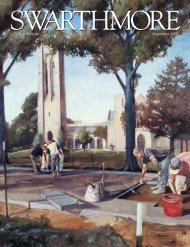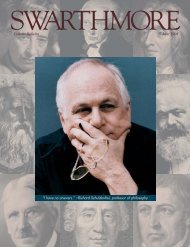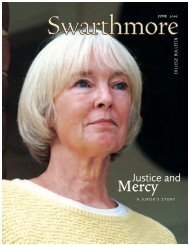more’s student-athletes doubtless have astronger academic profile than UVA’s,Swarthmore will still be reserv<strong>in</strong>g, <strong>in</strong> proportionalterms, three times <strong>the</strong> number ofathlete slots <strong>in</strong> each enter<strong>in</strong>g class, evenafter elim<strong>in</strong>at<strong>in</strong>g football.As an educator, it astounds and disturbsme that some <strong>in</strong> <strong>the</strong> College communityth<strong>in</strong>k it would do no harm to push <strong>the</strong> numberof recruited athletes to 20 percent orhigher. Even at <strong>the</strong> Division III level, athleticsrecruit<strong>in</strong>g significantly alters—and <strong>in</strong>many cases weakens—<strong>the</strong> academic profileof <strong>the</strong> student body. If that were not <strong>the</strong>case, <strong>the</strong>re would be no controversy, and all<strong>the</strong> teams could be filled with walk-ons.Swarthmore is, and will rema<strong>in</strong>, <strong>in</strong> manyways more <strong>in</strong>vested <strong>in</strong> its sports programsthan “football schools” like UVA. The College’sdecision to limit athletics recruitmentis wise, responsible, and <strong>the</strong> only decisionfor an academically serious <strong>in</strong>stitution.JOSHUA DIENSTAG ’86Charlottesville, Va.SHORT-SIGHTED DECISIONI f<strong>in</strong>d <strong>the</strong> College’s decision to elim<strong>in</strong>ate certa<strong>in</strong><strong>in</strong>tercollegiate sports, particularly football,to be extremely shortsighted and certa<strong>in</strong>lyto <strong>the</strong> detriment of <strong>the</strong> College; studentbody; and, shortly, Swarthmore’s reputationas a well-rounded academic <strong>in</strong>stitution.From <strong>the</strong> publicity given this action, Ican only conclude that <strong>the</strong> agendas of a fewthoroughly trampled <strong>the</strong> desires and wishesof many.RICHARD KERSEY ’58Trumbull, Conn.LOVE SWARTHMORE, LOATHE DECISIONI love Swarthmore. But I loa<strong>the</strong> your decisionto abandon <strong>the</strong> football program.As a former lacrosse player, <strong>the</strong>oretically Ishould applaud <strong>the</strong> ostensible goal ofrecruit<strong>in</strong>g more lacrosse players (with <strong>the</strong>now-available football slots). But some of<strong>the</strong> very best lacrosse players on our verybest lacrosse team (1982) never played <strong>the</strong>sport until [former coach] Jim Noyes wentto <strong>the</strong> football team after its season and gaveanyone who wanted one a lacrosse stick.And thus were born Eddie Meehan, JohnHiros, all <strong>the</strong> Walsh bro<strong>the</strong>rs, and so manyo<strong>the</strong>r great Swarthmore lacrosse players.ADAM REEVES ’85New YorkTHE ATHLETICS DECISIONAND QUAKER PROCESSI write <strong>in</strong> order to present one QuakerBoard member’s perspective on Friends’decision-mak<strong>in</strong>g processes and <strong>the</strong> decisionsmade at <strong>the</strong> meet<strong>in</strong>g of <strong>the</strong> Board ofManagers on Dec. 2.When decisions are made by groups ofQuakers both <strong>in</strong> <strong>the</strong>ir meet<strong>in</strong>gs (monthly,quarterly, and yearly) and <strong>in</strong> <strong>the</strong> nonprofitorganizations that <strong>the</strong>y oversee, deliberationsare carried out dur<strong>in</strong>g what is called aMeet<strong>in</strong>g for Worship for Bus<strong>in</strong>ess. At <strong>the</strong>semeet<strong>in</strong>gs—which are fundamentally religious<strong>in</strong> character—Friends are expected tomeditate, pray, and seek God’s will <strong>in</strong> reach<strong>in</strong>gwhat Friends refer to as “<strong>the</strong> sense of<strong>the</strong> meet<strong>in</strong>g.” That is what is meant by“m<strong>in</strong>d<strong>in</strong>g <strong>the</strong> Light.” All who ga<strong>the</strong>r areexperienced <strong>in</strong> <strong>the</strong> process of seek<strong>in</strong>g God’swill, all are committed to <strong>the</strong> centrality of<strong>the</strong> spiritual and religious bases of decisionmak<strong>in</strong>g, and all accept <strong>the</strong> premise that<strong>the</strong>re can be no decision until <strong>the</strong> sense of<strong>the</strong> meet<strong>in</strong>g is reached.In organizations governed by Friendswhose boards <strong>in</strong>clude non-Friends (generallyfewer than half), tra<strong>in</strong><strong>in</strong>g <strong>in</strong> and commitmentto <strong>the</strong>se pr<strong>in</strong>ciples is expected. As alifelong Friend and a participant <strong>in</strong> andclerk of many Quaker groups and organizations,I have a deep conviction about <strong>the</strong>power of this k<strong>in</strong>d of decision mak<strong>in</strong>g.S<strong>in</strong>ce my student days at Swarthmore <strong>in</strong><strong>the</strong> 1960s, however, I have understood thatSwarthmore College is not fundamentally areligious <strong>in</strong>stitution and that most peoplewho become associated with it have had littlecontact with Friends. At <strong>the</strong> same time, Ihave been impressed that <strong>the</strong> College hasma<strong>in</strong>ta<strong>in</strong>ed <strong>the</strong> Friends’ traditions of commitmentto peace and justice, a commitmentto service to <strong>the</strong> community and socialchange, and a belief <strong>in</strong> m<strong>in</strong>imiz<strong>in</strong>g <strong>the</strong>material and uphold<strong>in</strong>g moral and ethicalgoals.One aspect of <strong>the</strong> Friends’ tradition thathas cont<strong>in</strong>ued at Swarthmore has been <strong>the</strong>practice of <strong>the</strong> Board of Managers of mak<strong>in</strong>gdecisions without tak<strong>in</strong>g votes. Indeed,<strong>in</strong> <strong>the</strong> 12 years I served, <strong>the</strong> Dec. 2 meet<strong>in</strong>gwas <strong>the</strong> only time <strong>the</strong> process of vot<strong>in</strong>g wasused. At no time dur<strong>in</strong>g my years, on <strong>the</strong>o<strong>the</strong>r hand, were decisions made accord<strong>in</strong>gto <strong>the</strong> manner of Friends.Meet<strong>in</strong>gs of <strong>the</strong> Board of Managers arenot considered to be Meet<strong>in</strong>gs for Worship.There is no common sense of seek<strong>in</strong>g God’swill, nor is <strong>the</strong>re any provision <strong>in</strong> <strong>the</strong> charteror <strong>the</strong> bylaws—as <strong>the</strong>re would be <strong>in</strong> a Quakerorganization—about <strong>the</strong> requirementsfor mak<strong>in</strong>g decisions accord<strong>in</strong>g to <strong>the</strong> senseof <strong>the</strong> meet<strong>in</strong>g. Ra<strong>the</strong>r, <strong>the</strong>re has been anunderstand<strong>in</strong>g that consensual decisions arevaluable because <strong>the</strong>y do not create a victoriousmajority and a defeated m<strong>in</strong>ority,because <strong>the</strong> expectation of consensual decisionmak<strong>in</strong>g often discipl<strong>in</strong>es members toexplore all <strong>the</strong> alternatives and arguments <strong>in</strong><strong>the</strong> greatest depth, and because a decisionbeh<strong>in</strong>d which people are able to unite isusually more powerful <strong>in</strong> convey<strong>in</strong>g <strong>the</strong> willof <strong>the</strong> group than decisions made <strong>in</strong> o<strong>the</strong>rways. It is my understand<strong>in</strong>g that <strong>the</strong> practiceof consensual decision mak<strong>in</strong>g is nowcommonly thought to be <strong>the</strong> most effectivemethod <strong>in</strong> many nonprofit organizations.The decision before <strong>the</strong> Board of Managerslast December was a complex and difficultone <strong>in</strong> many ways. The factors underconsideration by <strong>the</strong> Board had been develop<strong>in</strong>gfor 20 or 30 years, not only atSwarthmore but also across <strong>the</strong> country atour sister schools. Unfortunately, <strong>the</strong> Boardand adm<strong>in</strong>istration did not fully understand<strong>the</strong> urgency of <strong>the</strong>se issues for our missionand policies until <strong>the</strong> fall of 1999. At <strong>the</strong>December 1999 meet<strong>in</strong>g, President AlfredH. Bloom brought to <strong>the</strong> Board’s attention<strong>the</strong> need to consider and resolve <strong>the</strong> tw<strong>in</strong>problems of athletes’ and coaches’ <strong>in</strong>creas<strong>in</strong>gdissatisfaction with <strong>the</strong>ir experience of<strong>in</strong>tercollegiate athletic competition atSwarthmore and <strong>the</strong> <strong>in</strong>creas<strong>in</strong>g pressuresfrom athletic recruitment on admissions.For not recogniz<strong>in</strong>g <strong>the</strong> great importance of<strong>the</strong> develop<strong>in</strong>g issues 5 or 10 years ago, wemust all take responsibility.After hear<strong>in</strong>g from <strong>the</strong> president, <strong>the</strong>Board moved quickly to ask <strong>the</strong> adm<strong>in</strong>istrationto form an Athletics Review Committee(ARC). The goal of <strong>the</strong> Board was to have all<strong>the</strong> <strong>in</strong>formation it would need for a thoroughdeliberation of <strong>the</strong> issues. We did notask <strong>the</strong> ARC to determ<strong>in</strong>e what was <strong>the</strong>most popular decision among any group,whe<strong>the</strong>r students, faculty, or alumni, butra<strong>the</strong>r to <strong>in</strong>clude <strong>the</strong> whole range of perspectives<strong>in</strong> <strong>the</strong>ir material and recommendations.At this po<strong>in</strong>t, those of us on <strong>the</strong> Boardmade a second mistake. We extended <strong>the</strong>M A R C H 2 0 0 177
L E T T E R SS W A R T H M O R E C O L L E G E B U L L E T I Ndate set for a decision from December 2000to May 2001 without tak<strong>in</strong>g sufficiently <strong>in</strong>toaccount <strong>the</strong> seasons of <strong>the</strong> College year and<strong>the</strong> implications of a delay of a decision onour part on <strong>the</strong> lives of students, coaches,and potential students.Just prior to <strong>the</strong> Board meet<strong>in</strong>g <strong>in</strong>December, many suggested that mak<strong>in</strong>g adecision <strong>the</strong> follow<strong>in</strong>g May was tantamountto mak<strong>in</strong>g an immediate decision to endfootball, <strong>in</strong> particular, because of <strong>the</strong> tim<strong>in</strong>g.The Admissions Office clearly stated that itwas unprofessional and unethical for <strong>the</strong>mto recruit athletes for teams whose futureswere unclear.Moved by <strong>the</strong>se arguments, <strong>the</strong> Board atits December meet<strong>in</strong>g decided that <strong>the</strong>rewere compell<strong>in</strong>g reasons to make <strong>the</strong> decision<strong>in</strong> December. This issue was deeplyengaged, with many Board members speak<strong>in</strong>gto <strong>the</strong> question. After a period of discussion,it was clear that those with widelyvary<strong>in</strong>g op<strong>in</strong>ions on <strong>the</strong> specific recommendationsof <strong>the</strong> ARC were <strong>in</strong> firm agreementthat <strong>the</strong> worst possible option was to postpone<strong>the</strong> decision. This decision was madeby consensus, with no one stand<strong>in</strong>g asidefrom it and with <strong>the</strong> passionate support ofmany Board members who disagreed wi<strong>the</strong>ach o<strong>the</strong>r on <strong>the</strong> recommendations.Yet at <strong>the</strong> moment that we decidedthrough consensus that an immediate decisionwas necessary, we knew that we mightnot be able to decide on <strong>the</strong> specific recommendationsof <strong>the</strong> ARC by consensus.Although a large majority favored <strong>the</strong> ARCrecommendations, several members cont<strong>in</strong>uedto believe strongly that <strong>the</strong> recommendationswere wrong, and that o<strong>the</strong>r pathswould be best for <strong>the</strong> College. As this divisionbecame clearer, Chairman Shane askedeach of us to <strong>in</strong>dicate where we stood. Werealized that several people disagreed with<strong>the</strong> majority, but that <strong>the</strong>y had not raisedenough questions <strong>in</strong> <strong>the</strong> m<strong>in</strong>ds of <strong>the</strong>majority to change <strong>the</strong>ir views. It was alsoclear that <strong>the</strong> majority would not be able tochange <strong>the</strong> m<strong>in</strong>ds of at least some of those<strong>in</strong> <strong>the</strong> m<strong>in</strong>ority. At that po<strong>in</strong>t, hav<strong>in</strong>g agreedon <strong>the</strong> importance of reach<strong>in</strong>g a decision atthis meet<strong>in</strong>g, we reached a consensus thatwe should let <strong>the</strong> division stand—and thatwe would, for <strong>the</strong> record, consider <strong>the</strong> decisionabout <strong>the</strong> recommendations to havebeen made by a vote. Had we believed thatwe could have delayed <strong>the</strong> decision, wewould have agreed to cont<strong>in</strong>ue <strong>the</strong> discussionat later meet<strong>in</strong>gs, <strong>in</strong> hopes of reach<strong>in</strong>gconsensus.Dur<strong>in</strong>g <strong>the</strong> December meet<strong>in</strong>g, we allunderstood that <strong>the</strong> circumstances that ledus to a vote were unfortunate but unavoidable.Not be<strong>in</strong>g required to make every decisionby consensus, we made an exceptionfor what we believed were compell<strong>in</strong>g reasons.We also believed, however, that wewere creat<strong>in</strong>g <strong>the</strong> wisest possible process,given <strong>the</strong> circumstances, and that we wereact<strong>in</strong>g <strong>in</strong> <strong>the</strong> best <strong>in</strong>terests of <strong>the</strong> College.Throughout this difficult process, I haveperceived members of <strong>the</strong> Board to be <strong>in</strong>agreement that consensual decision mak<strong>in</strong>gis <strong>the</strong> preferred practice, that this <strong>in</strong>stancewas an exception to our traditional method,and that we felt a sense of deep regret aboutf<strong>in</strong>d<strong>in</strong>g ourselves fac<strong>in</strong>g <strong>the</strong> necessity of adivided decision. As much as it is possibleand appropriate for a secular <strong>in</strong>stitutionwith a Quaker tradition to be, I believe thatSwarthmore College and its Board of Managerskeeps <strong>the</strong> <strong>in</strong>spiration and good practicesof <strong>the</strong> Society of Friends before <strong>the</strong>mas <strong>the</strong>y strive to carry out <strong>the</strong> mission of <strong>the</strong>College <strong>in</strong> <strong>the</strong>ir policies and decisions.DULANY OGDEN BENNETT ’66Portland, Ore.Bennett’s term on <strong>the</strong> Board of Managers ended<strong>in</strong> December after 12 years of service.UNSTATED SUBTEXTThe arguments put forth by <strong>the</strong> AthleticsReview Committee to expla<strong>in</strong> <strong>the</strong> decisionsmade about <strong>the</strong> complex issues of athleticsat Swarthmore appear to be rational. However,<strong>the</strong>re exists an unstated subtext thatrequires fur<strong>the</strong>r analysis and open discussion.This subtext is <strong>the</strong> consistent viewheld by many <strong>in</strong> <strong>the</strong> academic community ofSwarthmore that sports are a waste of timeand that <strong>in</strong>tellect is all. A barely hidden battlehas taken place for decades betweenthose who hold this position and o<strong>the</strong>rswho believe that <strong>in</strong>tercollegiate competitionhas a vital place <strong>in</strong> <strong>the</strong> life of <strong>the</strong> school. Itmay well be that proponents of <strong>the</strong> formerview have seen <strong>the</strong>ir opportunity, grasped it,and triumphed.I f<strong>in</strong>d it hard to believe that <strong>in</strong> <strong>the</strong> easternhalf of <strong>the</strong> United States our collegecannot f<strong>in</strong>d eight o<strong>the</strong>r schools with footballteams that recruit athletes with<strong>in</strong> <strong>the</strong>limits that Swarthmore f<strong>in</strong>ds appropriateand that would provide competition more orless equal to what we can offer.Swarthmore’s reputation as an effete<strong>in</strong>stitution is not its strongest asset. Thisdecision makes it worse and is especiallytroublesome if it was made for <strong>the</strong> wrong—and as yet unacknowledged—reasons.PHILIP BRICKNER ’50New York CityAGAINST COMPETITIONWhat value is obta<strong>in</strong>ed from <strong>in</strong>tercollegiatesports that cannot equally be found <strong>in</strong> <strong>in</strong>tramurals—exceptcompetition? But s<strong>in</strong>cewhen has competition as such been a value<strong>in</strong> <strong>the</strong> Swarthmore community’s philosophy?Possibly <strong>the</strong>se th<strong>in</strong>gs run <strong>in</strong> cycles,and, some day not too far off, we will recoverour detachment and humor and rediscoverathletics as wonderful recreation—no moreand no less.I am pleased that <strong>the</strong> Board could notreach consensus on this issue. I trust thatwas because at least some could not support<strong>the</strong> idea of support<strong>in</strong>g 21 (!) <strong>in</strong>tercollegiatesports.ROBERT HILLEGASS ’49Greenfield, N.H.ATHLETES COMPETING IN CLASSROOMSIt is simply a fallacy to believe that [athletics]recruitment efforts are synonymouswith allocation of admissions spaces forundeserv<strong>in</strong>g applicants.I state this strongly because of my experiencesas a member of <strong>the</strong> men’s soccerteam dur<strong>in</strong>g <strong>the</strong> years between 1989 to1993. Dur<strong>in</strong>g this period, our team washighly competitive, not only locally butnationally. We won our division 3 times,advanced to <strong>the</strong> Mid-Atlantic Conferencesemif<strong>in</strong>als twice, qualified for <strong>the</strong> NationalChampionships twice, and advanced to <strong>the</strong>f<strong>in</strong>al 16 <strong>in</strong> <strong>the</strong> country once. And, concurrentwith <strong>the</strong>se athletic achievements, myteammates were succeed<strong>in</strong>g at similar rates<strong>in</strong> <strong>the</strong> classroom.To use an admittedly simplistic yardstickof <strong>the</strong> academic credentials of my teammatesdur<strong>in</strong>g those four years, I quicklycount eight who have received Ph.D.s (<strong>in</strong>economics, ma<strong>the</strong>matics, psychology, chemistry,classics, and philosophy), four whohave received M.D.s, three who havereceived M.A.s, and one who received a J.D.Undoubtedly, <strong>the</strong>re are o<strong>the</strong>rs who have78
















